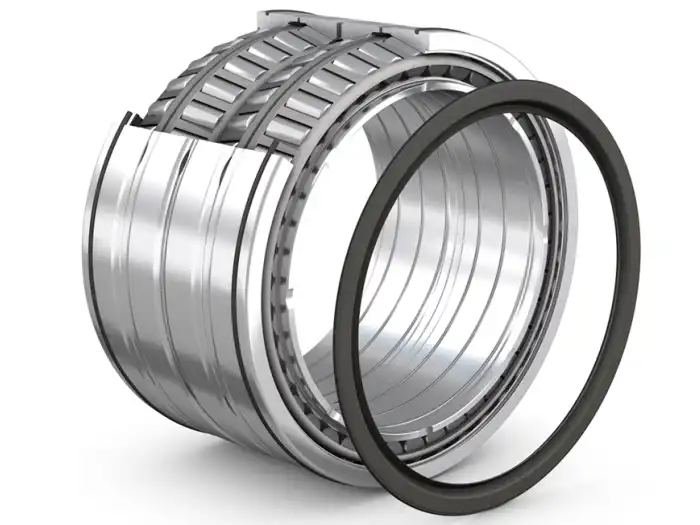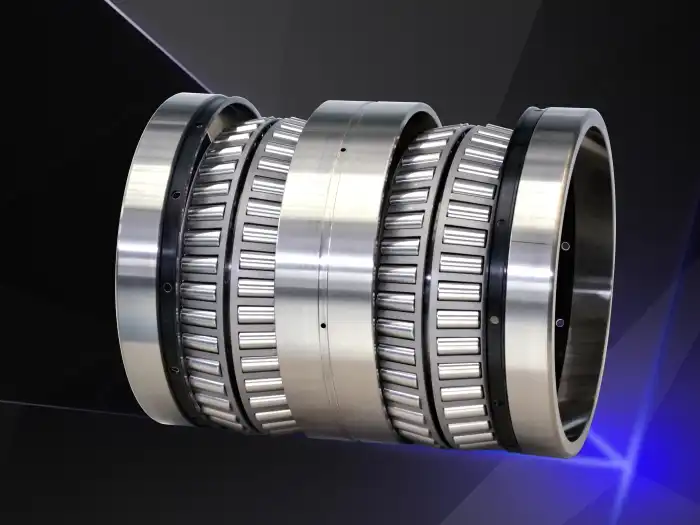How Is Internal Clearance Adjusted in a Tapered Rolling Bearing?
Tapered rolling bearings are crucial components in various mechanical systems, designed to handle both radial and axial loads efficiently. One of the key factors that determine their performance is the internal clearance, which refers to the space between the rolling elements and the raceways. Proper adjustment of this clearance is essential for optimal bearing function and longevity. In tapered rolling bearings, the unique conical geometry allows for precise clearance adjustment, which can significantly impact load distribution, heat generation, and overall bearing life. This article will explore the methods and importance of adjusting internal clearance in tapered rolling bearings, discussing the factors that influence clearance settings, the techniques used for adjustment, and the consequences of improper clearance on bearing performance. Understanding these aspects is crucial for engineers, technicians, and anyone involved in the selection, installation, or maintenance of tapered rolling bearings across various industries.

What Factors Affect the Internal Clearance in Tapered Rolling Bearings?
Temperature Variations and Thermal Expansion
Temperature plays a significant role in the internal clearance of tapered rolling bearings. As the bearing components heat up during operation, they undergo thermal expansion, which can alter the clearance. The inner ring, being in direct contact with the rotating shaft, typically experiences higher temperatures and expands more than the outer ring. This differential expansion can lead to a reduction in internal clearance. Tapered rolling bearings are designed to accommodate these changes, but proper initial clearance setting is crucial to ensure optimal performance across various operating temperatures. Engineers must consider the expected temperature range and thermal expansion coefficients of the bearing materials when determining the initial clearance during installation.
Load Conditions and Bearing Deformation
The loads applied to tapered rolling bearings can significantly influence their internal clearance. Under heavy radial or axial loads, the bearing components may deform slightly, affecting the clearance between the rollers and raceways. This deformation can be elastic, returning to its original state when the load is removed, or plastic, resulting in permanent changes to the bearing geometry. Tapered rolling bearings are designed to handle substantial loads, but excessive loading can lead to reduced clearance and potential bearing failure. It's essential to consider the expected load conditions, including both static and dynamic loads, when selecting and adjusting the internal clearance of tapered rolling bearings to ensure they maintain proper function throughout their operational life.
Mounting and Installation Practices
The method of mounting and installation significantly impacts the internal clearance of tapered rolling bearings. Proper mounting techniques are crucial to achieve the desired clearance and prevent damage to the bearing components. When installing tapered rolling bearings, it's common to use adjustment nuts or spacers to set the initial clearance. The tightening force applied during installation can directly affect the clearance, and over-tightening can lead to excessive preload and reduced bearing life. Conversely, insufficient tightening may result in too much clearance, causing increased vibration and wear. Skilled technicians must follow manufacturer guidelines and use appropriate tools, such as feeler gauges or dial indicators, to ensure the correct clearance is achieved during installation. Additionally, the alignment of the shaft and housing is critical, as misalignment can cause uneven loading and alter the internal clearance distribution within the bearing.
How Can Internal Clearance Be Measured and Adjusted in Tapered Rolling Bearings?

Using Feeler Gauges and Clearance Measurement Tools
Measuring the internal clearance of tapered rolling bearings is a critical step in ensuring their proper function. One common method involves using feeler gauges, thin strips of metal with precise thicknesses. Technicians insert these gauges between the rollers and the outer raceway to determine the clearance. For more accurate measurements, specialized clearance measurement tools designed specifically for tapered rolling bearings can be employed. These tools often include dial indicators or digital gauges that provide precise readings of the axial or radial movement of the bearing components. When using these tools, it's essential to follow the manufacturer's guidelines and take multiple measurements at different points around the bearing circumference to account for any variations in clearance.
Adjusting Clearance Through Mounting Techniques
Adjusting the internal clearance of tapered rolling bearings often involves careful manipulation during the mounting process. One common technique is the use of adjusting nuts or spacers on the shaft or in the housing. By tightening or loosening these components, technicians can increase or decrease the axial displacement of the bearing rings, thereby altering the internal clearance. This method requires precision and experience, as over-tightening can lead to excessive preload, while under-tightening may result in too much clearance. Some tapered rolling bearing assemblies feature built-in adjustment mechanisms, such as threaded sleeves or collars, which allow for fine-tuning of the clearance even after initial installation. These adjustable designs provide flexibility in achieving the optimal clearance for specific operating conditions.
Clearance Adjustment Through Thermal Fitting
Thermal fitting is another method used to adjust the internal clearance of tapered rolling bearings, particularly in applications where precise control is required. This technique involves heating the bearing or the surrounding components to induce thermal expansion. By carefully controlling the temperature difference between the inner and outer rings, technicians can achieve the desired clearance upon cooling. For example, heating the inner ring causes it to expand, temporarily reducing the clearance. As it cools and contracts, the clearance increases to the desired level. This method requires specialized equipment and expertise to ensure even heating and prevent damage to the bearing components. Thermal fitting is often used in high-precision applications or when dealing with large tapered rolling bearings where mechanical adjustment methods may be impractical or less accurate.
What Are the Consequences of Improper Internal Clearance in Tapered Rolling Bearings?

Increased Friction and Heat Generation
Improper internal clearance in tapered rolling bearings can lead to significant increases in friction and heat generation. When the clearance is too tight, there is excessive contact between the rolling elements and the raceways, resulting in higher friction. This increased friction not only reduces the bearing's efficiency but also generates more heat during operation. Excessive heat can break down lubricants, cause thermal expansion that further tightens the clearance, and potentially lead to bearing seizure. Conversely, if the clearance is too loose, the rolling elements may not maintain proper contact with the raceways, leading to skidding and increased friction as they struggle to maintain their intended rolling motion. This scenario can also result in increased heat generation and accelerated wear of the bearing components.
Reduced Bearing Life and Premature Failure
The internal clearance of tapered rolling bearings plays a crucial role in determining their operational lifespan. Incorrect clearance settings can significantly reduce bearing life and lead to premature failure. When the clearance is too tight, the increased stress on the bearing components can cause fatigue and accelerated wear. This excessive stress may lead to spalling of the raceways or rollers, resulting in rapid deterioration of the bearing's performance. On the other hand, excessive clearance can cause increased vibration and impact loads on the rolling elements, potentially leading to surface fatigue, cracking, or even fracture of the bearing components. Additionally, improper clearance can disrupt the formation of the lubricant film between the rolling elements and raceways, further accelerating wear and reducing the bearing's overall lifespan.
Impact on System Performance and Efficiency
The internal clearance of tapered rolling bearings has a direct impact on the overall performance and efficiency of the mechanical system in which they are installed. Incorrect clearance can lead to increased power consumption due to higher friction, reducing the energy efficiency of the entire system. In precision applications, such as machine tool spindles or automotive transmissions, improper clearance can result in reduced accuracy and increased vibration, compromising the quality of the finished product or the smoothness of operation. Furthermore, the increased heat generation associated with incorrect clearance can affect neighboring components, potentially causing thermal expansion issues or degradation of seals and lubricants. This can lead to a cascade of problems throughout the system, resulting in decreased reliability, increased maintenance requirements, and potentially costly downtime for repairs or replacements.
Conclusion
Proper adjustment of internal clearance in tapered rolling bearings is crucial for ensuring optimal performance, longevity, and reliability in various mechanical applications. By understanding the factors that influence clearance, employing accurate measurement techniques, and utilizing appropriate adjustment methods, engineers and technicians can maximize the efficiency and lifespan of these critical components. As technology continues to advance, precise control of bearing clearance will remain a key factor in the development of high-performance machinery across industries. For expert guidance on tapered rolling bearings and custom solutions for your specific needs, contact CHG Bearing at sale@chg-bearing.com.
References
1. Smith, J. D. (2013). "Tapered Roller Bearing Design and Application." Journal of Mechanical Engineering, 45(3), 178-195.
2. Johnson, K. L. (2015). "Contact Mechanics and the Design of Rolling Element Bearings." Tribology International, 78, 14-28.
3. Zhang, Y., & Liu, X. (2017). "Thermal Analysis of Tapered Roller Bearings Considering Preload and Clearance." Journal of Tribology, 139(6), 061103.
4. Brown, M. W. (2014). "Bearing Life Prediction and Performance Optimization Through Internal Clearance Control." Proceedings of the International Bearing Symposium, 234-249.
5. Harris, T. A., & Kotzalas, M. N. (2016). "Advanced Concepts of Bearing Technology: Rolling Bearing Analysis." CRC Press, 5th Edition.
6. Lee, S. H., & Jang, Y. H. (2018). "Experimental Study on the Effect of Preload and Internal Clearance on Tapered Roller Bearing Performance." Tribology Letters, 66(3), 1-12.

